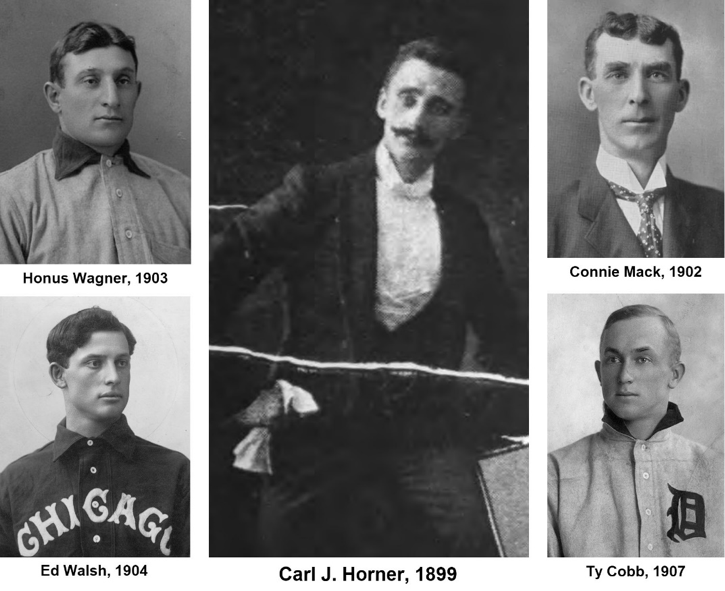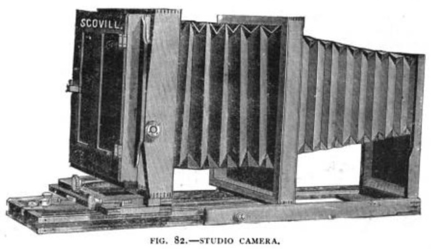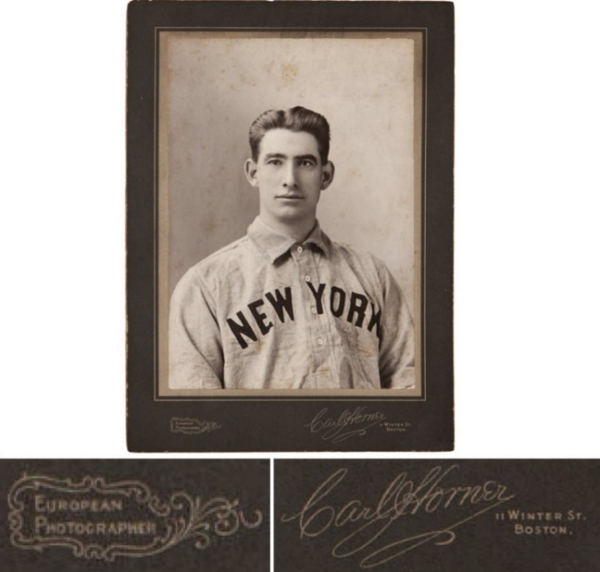Carl J. Horner
“The real artist in photography … makes it his principal point to make his sitter feel at home, [to] bring out a good expression and a natural pose.”1 — Carl J. Horner, 1901
Carl J. Horner enjoyed a 40-year career in photography. At a portrait studio in Boston, he expertly captured images of people from all walks of life. Among them were ballplayers. In 1903 he was recognized by Sporting Life as the “official photographer” of the major leagues.2 His portraits of players in the Deadball Era are iconic. His photographic record of the game is priceless.
Carl Johan Horner was born in Stockholm, Sweden, on January 28, 1864. His parents were Carl Wilhelm Ludvig Horner (1830-1882), a successful restaurateur in Stockholm, and Josephina Charlotta Mathilda (née Broman) Horner (1829-1911). He had four older and two younger siblings: brothers Carl Wilhelm Horner (1856-1875), Axel Ludwig Fredrik Horner (1857-1951), and Fritiof August Horner (1860-1928); sisters Ingeborg Charlotta Mathilda Horner (1862-1865) and Sigrid Anna Sofia Horner (1866-1927); and brother Conrad Knut Horner (1870-1882).
In the fall of 1883, at age 19, Carl Johan Horner came to America. His father had died the year before from a cerebral hemorrhage, and three of his six siblings were deceased. His mother and three siblings (Axel, Fritiof, and Sigrid) remained in Stockholm.
From 1885 to 1888, Horner worked as an assistant photographer in the Boston studio of Ernest A. F. Ritz, a fellow Swede. The Boston Globe reported in April 1886 that Ritz’s employees had formed a baseball team and Horner was the second baseman.3 This suggests that for Horner, baseball portraiture would not be solely a business interest; he was a fan of the American game.
In 1888 Horner went back to Stockholm and returned to Boston with his brother Axel. The pair went to work that fall at a portrait studio opened by George Waldon Smith, who had been Ritz’s business manager.4 But they weren’t there for long. In the spring of 1889, Horner purchased the studio of Nicholas R. Worden at 48 Winter Street in Boston.5 Horner was assisted by his brother for a decade, until Axel relocated to Brooklyn about 1900 to operate a studio there.6
On September 20, 1892, the 28-year-old Horner married 20-year-old Thorella M. C. Rosengren, a daughter of Swedish immigrants. Carl and Thorella had only one child, daughter Estelle Charlotte L. Horner, born in July 1893. The following year, the family moved to 10 Shenandoah Street in the Ashmont section of the Dorchester neighborhood of Boston. It would be the family home until Estelle’s death in 1978.
By the 1890s, photography had been part of American life for 50 years. Albert Sands Southworth and Josiah Johnson Hawes opened a portrait studio in Boston in 1843 and used the daguerreotype process invented by Louis J. M. Daguerre in France in 1839.7
From 1895 to 1905, Horner’s studio was located at 11 Winter Street, above the Gilchrist department store. Take the elevator to the studio, said one of his ads, for “artistic and first-class photographs at moderate prices.”8 It is unknown what equipment he used. His camera may have resembled this Scovill model with double bellows, which was described in 1896 as “a perfect form of studio camera for portrait work.”9 From negatives he made gelatin silver prints10 following the standard practice of the day.
Horner was one of 110 photographers listed in the 1895 Boston city directory, but he stood out among his competitors. He was in demand for taking portraits of students of local high schools and colleges.11 In 1896 he entered a formal competition and won an award from the National Association of Photographers.12 And in 1899 he was one of only two Boston photographers selected for a list of 42 “prominent portrait photographers of the United States.”13
Newspapers needed portraits to accompany articles, and beginning in 1901, the Boston Post was one of Horner’s repeat customers. The Post published his photos of cyclists, swimmers, gymnasts, bowlers, football and basketball players, and, starting in 1902, baseball players.
After the Philadelphia Athletics won the 1902 American League pennant, the Post published an article that included Horner’s portraits of Athletics manager Connie Mack, pitcher Rube Waddell, and third baseman Lave Cross.14 Horner took portraits of nearly every AL player and manager in 1902,15 and nearly every NL player and manager in 1903.16 In this prodigious undertaking, he photographed more than 250 individuals. As visiting teams came to Boston to play the local major-league teams, he was ready to photograph them. Players were in uniform but wore no cap and were photographed from the waist up. Managers were typically in plain clothes.
Sporting Life became one of Horner’s major customers. The Philadelphia-based weekly disseminated baseball news to a national audience. In 1903 it reported that Horner was “the only photographer in the country who can supply upon demand the photograph of any manager or player in either major league.”17 His portraits appeared also in prominent baseball annuals, Spalding’s Official Base Ball Guide and Reach’s Official American League Base Ball Guide.
Horner offered directly to fans his portraits on 5-by-7-inch cabinet cards. The price was 35 cents each18 (about $12 in 2023 dollars). They were on display in his studio and were “greatly admired by baseball enthusiasts.”19
This cabinet card was produced by Horner from his 1903 portrait of Roger Bresnahan. Note Horner’s signature and studio address at lower right. In the spring of 1905, he moved his studio from 11 Winter Street to 387 Washington Street.20 The Winter Street address on this card indicates that it was made between 1903 and 1905. At lower left, Horner advertised that he was a European photographer, suggesting the artistry and sophistication of a European portrait painter.
The Boston Journal described Horner’s Washington Street studio. It was staffed by 13 employees, including Horner, and consisted of several rooms on the eighth floor and a print room on the roof of the building. There were dressing rooms for customers, a waiting room, an office, “mounting and chemical rooms,” and a dark room. Photographs were taken in the “working room.” In the print room, more than 1,800 photographic prints could be produced in a single day.21
Horner regularly photographed major-leaguers until 1909, including established veterans and rising stars, and obscure players who would have brief careers.22 Though ballplayers of this era were a rough bunch, Horner made them look like princes. Following a practice that was common then (and still in use today), he applied touch-ups to mask facial imperfections.
Here is one of the team composites distributed by Sporting Life during this period. For these collages, Horner’s portraits were cropped and arranged, possibly by Horner himself.23 Though dated 1906, this composite depicts members of the world-champion 1905 New York Giants and was published in the October 21, 1905, issue of Sporting Life.
Sporting Life also issued a series of more than 600 individual portraits on cabinet cards. Not all, but probably more than half, were Horner’s portraits.24
Horner’s work can be seen in at least a dozen baseball card sets of the era. His portraits of American Leaguers appeared on cards distributed with caramel from 1903 to 1904 by the Breisch-Williams Company of Oxford, Pennsylvania. Both his AL and NL portraits appeared in decks of game cards distributed from 1905 to 1906 by the Fan Craze Company of Cincinnati. They also appeared in the 1909 Ramly cigarette card set from the Mentor Company of Boston and the 1909-11 “Colgan’s Chips” set from the Colgan Gum Company of Louisville.
Unknown artists applied color to Horner’s portraits, and these “colorized” versions appeared in several more card sets issued between 1909 and 1911. These include sets distributed by Sporting Life; the Philadelphia Caramel Company of Camden, New Jersey; the American Caramel Company of Philadelphia; the Williams Caramel Company of Oxford, Pennsylvania – and, notably, the T206 cigarette card set from the American Tobacco Company of Durham, North Carolina.25
If there is a “Mona Lisa” of baseball portraits, it is Horner’s 1903 portrait of Honus Wagner.26 A colorized version was distributed in small quantity as part of the T206 set. In 2022, one of these rare T206 Wagner cards was sold for $7.25 million.27
Here we see Horner’s 1902 portrait of Nap Lajoie on three cards produced between 1905 and 1911: a Sporting Life cabinet card on the left; a T206 cigarette card in the upper right; and a Fan Craze game card in the lower right. A Lajoie cabinet card like this one was sold in 2016 for $40,992.28 In 2024, a T206 Lajoie portrait in near mint condition sold for $15,600.29
Horner’s portraits appeared also on postcards from the Rose Company of Philadelphia, the Rotograph Company of New York, and the Souvenir Post Card Shop of Cleveland. And 16 of his portraits (one player from each major-league team) adorn the box that houses “Major League Indoor Base Ball,” a table-top game introduced in 1913 by the Philadelphia Game Manufacturing Company.30
Active socially, Horner was a member of several organizations, including the Photographers’ Club of New England,31 the Swedish Club of Boston,32 and the Swedish Masonic Club.33 And he was an avid yachtsman in the South Boston Yacht Club.34
In 1910 Horner moved his studio to 250 Huntington Avenue35 (one mile from Fenway Park), where he continued his work until 1926. After an illness of two months, he died at home on November 29, 1926, at the age of 62.36
Horner’s wife and daughter, Thorella and Estelle, operated the studio until the late 1930s. According to the 1930 US census, Thorella was a photographer and Estelle was the business manager. Thorella died on July 26, 1949, at the age of 77. Estelle died on October 21, 1978, at 85. Horner’s brother Axel worked as a photographer in Brooklyn until the 1920s; he died at age 94 on September 15, 1951.
By photographing hundreds of major leaguers from 1902 to 1909, Horner, a Swedish immigrant, helped to popularize the great American game, and he created a vivid record of the era for future generations to enjoy. Among his portraits are classic images of 10 of the first 13 men elected to the National Baseball Hall of Fame: Ty Cobb, Ban Johnson, Walter Johnson, Nap Lajoie, Connie Mack, Christy Mathewson, John McGraw, Tris Speaker, Honus Wagner, and Cy Young. In 2024, the Hall honored the contributions of Horner and other baseball photographers in a traveling exhibition titled Picturing America’s Pastime: A Snapshot of the Photograph Collection at the National Baseball Hall of Fame and Museum.
Acknowledgments
Genealogist Johan Grönberg obtained information about Horner’s family from Swedish archives. Larry S. Pierce and David Cycleback advised on antique photographic equipment and methodology.
This biography was reviewed by Bill Lamb and Rory Costello and fact-checked by Larry DeFillipo.
Sources
These online sources were accessed in April 2024: Ancestry.com, Baseball-Reference.com, OldCardboard.com, and TCDB.com (Trading Card Database).
Chapman, Jim. Baseball Photography of the Deadball Era (self-published), 2023, chapmandeadballcollection.com.
Polito, Ron, ed. A Directory of Massachusetts Photographers, 1839-1900 (The Online Edition), 2018.
Standard Catalog of Vintage Baseball Cards, 6th Edition (Iola, Wisconsin: Krause Publications), 2016.
The images in this article are in the public domain. The photo of Carl J. Horner is from the March 5, 1899, issue of the New York Telegraph.
Notes
1 Carl J. Horner, “Photography in 1901,” Boston Post, December 29, 1901: 20.
2 “The ‘Official Photographer,’” Sporting Life, June 20, 1903: 4.
3 “Amateur Clubs Organized,” Boston Globe, April 19, 1886: 2.
4 “G. Waldon Smith, Photographer,” Boston Globe, October 21, 1888: 3.
5 Boston Herald, May 29, 1889: 2.
6 Axel Horner’s studio was located at 222 Court Street in Brooklyn. He and Carl Horner were business partners until 1905.
7 “Photography’s Early Evolution, c. 1840-c. 1900,” at Britannica.com.
8 Advertisement in: The Posse Gymnasium Journal, Posse Gymnasium Club of Boston, October 1895: 12.
9 Walter E. Woodbury, The Encyclopaedic Dictionary of Photography (New York: Scovill & Adams Co., 1896), 75.
10 Sarah S. Wagner, “Gelatin Silver Prints,” National Gallery of Art Online Edition at NGA.com.
11 “Holiday Bargains 25% Discount,” Boston Globe, February 16, 1896: 18.
12 “The Photographers,” Buffalo Commercial, June 27, 1896: 15.
13 “The Prominent Portrait Photographers of the United States of America,” New York Telegraph, March 5, 1899. The other Boston photographer to make the list was Elmer Chickering.
14 “How Connie Mack’s ‘Pack of Discards’ Fought Their Way to the Top,” Boston Post, September 29, 1902: 3.
15 Jacob C. Morse, “Boston Briefs,” Sporting Life, September 13, 1902: 3.
16 “The ‘Official Photographer.’”
17 “The ‘Official Photographer.’”
18 “The ‘Official Photographer.’” Horner also offered for $2.50 each (about $85 in 2023 dollars) 26-by-21-inch composite photographs that show his portraits of nearly every player in the American or National League. The 1902 composite, with 123 AL portraits, can be seen at DigitalCommonwealth.org.
19 “Miscellaneous Sports,” National Police Gazette, April 22, 1905: 2.
20 “The Base Ball Photographer,” Sporting Life, April 8, 1905: 4.
21 “Best Arranged Studio in Boston Is Horner’s,” Boston Journal, September 20, 1905: 8.
22 Research for this article found no evidence that Horner photographed minor leaguers, but other portraitists did. One was Harvey C. Weasner of Buffalo who photographed Eastern League teams. Weasner’s portraits are similar in style to Horner’s.
23 Most, but not all, of the portraits used in Sporting Life team composites were taken by Horner.
24 Estimated by the author from the style of portrait. Plain-clothes images of Rube Waddell, Honus Wagner, and Christy Mathewson, for example, were likely not from Horner; they differ from Horner’s style and were published in Sporting Life between 1899 and 1901. For comparison, see the gallery of Sporting Life cabinet cards at OldCardboard.com.
25 “T206” is an identifier assigned by Jefferson Burdick in his classic reference, The American Card Catalog. ACC designations for other sets mentioned in this article are: American Caramel (E90), Philadelphia Caramel (E95 and E96), Williams Caramel (E103), Breisch-Williams (E107), Colgan’s Chips (E254), Ramly (T204), and Sporting Life (M116, W600, and W601).
26 Horner’s famous portrait of Honus Wagner appeared in the September 7, 1903, issue of the Boston Journal.
27 Dan Hajducky, “Rare T-206 Honus Wagner Baseball Card Sold for Record $7.25 Million in Private Sale,” August 4, 2022, at ESPN.com.
28 “Mile High Card Company May Auction Obliterates Previous Record Prices,” May 2016, at MileHighCardCo.com.
29 “1909-11 T206 Sweet Caporal 150/30 Napoleon Lajoie (Portrait) PSA NM 7,” January 26, 2024, at Heritage Auctions.
30 Mark Cooper with Douglas Congdon-Martin, Baseball Games: Home Versions of the National Pastime, 1860s-1960s (Atglen, Pennsylvania: Schiffer Publishing, 1995), 49.
31 “Photographers Club Dines,” Boston Globe, November 21, 1895: 5.
32 “Dance of the Swedish Club,” Boston Globe, January 26, 1894: 3.
33 “Swedish Masonic Club Banquet,” Boston Globe, June 15, 1905: 5.
34 “South Boston,” Boston Globe, January 26, 1900: 5.
35 “Real Estate Transactions,” Boston Globe, April 27, 1910: 3.
36 “Carl J. Horner Dies in Ashmont Home,” Boston Globe, November 30, 1926: 11. Horner’s burial place was not reported.
Full Name
Carl Johan Horner
Born
January 28, 1864 at Stockholm, (Sweden)
Died
November 29, 1926 at Boston, Massachusetts (US)
If you can help us improve this player’s biography, contact us.








